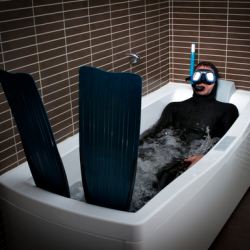Being the serious healthcare professional that I am, I view no task as too large or rigorous when it comes to ensuring the public’s safety. That's why I readily accepted the grueling assignment of investigating the “‘8 Wellness Trends for 2017- and Beyond’ as identified by the Global Wellness Summit.”
If we weren’t a non-profit, I would sacrifice for the greater public good and tackle this one on the front lines by going to fabulous saunas. After all, assessing and reviewing primary sources is always my mantra when rendering comprehensive and thorough “expert” opinions. But, alas, voluntarily subjecting myself to luxurious spa services around the world—though clearly vital— is apparently not “cost effective” or deemed “necessary.”
Can you believe it?! #unfair
So since I can’t spend our precious resources to experience silent spas and wellness monasteries firsthand, or appreciate “silent eating” or “silent therapists,” for now, I'm forced to just write about them.
I will convey what I glean from immersing myself in the materials from this global summit:
- There are lots of science and medical words intermingled, everywhere, made-to-fit any thing
- The document is a sales and marketing brochure endeavoring to champion science but is really just cherry picking to sell their goods and services
Let’s get real. Money is the motivation. If people are Zen in the process, so be it, and if inserting du jour fear terminology like "detoxifying" or "indoor air pollution super-crisis" brings in clients, then why not extend the branding to include "a world where rising inequality and a sense of "unfairness" is leading to global populist backlash-- a wellness industry that's become narrowly associated with wealthy elites must and will, change."
What speaks more to those suffering and embattled in rising political turmoil than hearing about someone else's self-indulgent revenue stream that most cannot afford? Will Obamacare be covering this? Now, THAT would be disruptive.
The Wellness world, per the program’s own experts, is a $3.7 trillion industry. The irony is that their literature concedes a dearth of studies on its health benefits, while claiming "the medical evidence for sauna isn’t vast (“Big Sauna” doesn’t have big bucks for clinical trials).” Huh?! It's $3.7 trillion!
Here’s the medical reality. Good sleep, routine exercise, healthy eating and connectedness to community or social interaction serve to promote well-being. Avoiding smoking, drugs, excess alcohol intake and modifying risky behaviors improves longevity.
Limiting toxic, extreme stress preserves not only optimal mental health, but also physical vitality (e.g. cardiovascular health). I have written extensively about the negative impact of chronic stress and the effects of the consequent sustained surge of adrenaline or cortisol (aka stress hormones), for instance, circulating in our systems. Endorphins are another buzzword that release upon pleasurable activity thereby stimulating favorable body and mind responses. (1)
Silence is a rare commodity in our noise-laden, nonstop action lifestyles. Today, being able to find comfort in the stillness is a lofty goal. Many struggle to achieve this stillness due to generalized anxiety and depression—issues currently abundant in our culture. Certainly, unplugging is essential to nurturing ourselves and developing peace.
That said, this marketing tool, along with the meeting’s mission to endorse lavish, constantly evolving —and sometimes wacky— trends or fads, leads us to wonder if the intended goal of relaxation and stress reduction can be attained through less expensive means.
You know, low cost versions of what they term Elite "Ghettos" of Wellness.
Here is a sampling of low budget alternatives (LBA) for their forecasted 8 Wellness Trends of 2017:
Trend #1 - Fly To A Silent Monastery
LBA: Go to your library and find the 18th century French poetry section. No one will bother you there.
Trend #2 - Sauna In An Amphitheater
- They offer: “From theatrical Sauna Aufguss events to jaw dropping amphitheater saunas…sweating will get more spectacular and social in the years ahead”
LBA: If you want to be surrounded by sweaty strangers in unreal heat, just hang out on a New York City subway platform in August. Stay hydrated.
Trend #3 - Get Your Building Designed By A Wellness Architect
- “The strategies will span the simple, like deploying plants that excel at removing deadly toxins, to the highest-tech, like “living” buildings with walls made of algae biofuel cells that grow their own energy or new phone apps that alert you when you’re entering a “sick” building.”
LBA: If you want to have decomposing plant matter in your house, just duct tape some kale on your wall. Or whatever the kale is for 2017.
In Conclusion...
You don't need to be rich. The ideal way to impact long-term well-being is to be consistent in managing personal stressors over time, making changes when necessary to meet this end while constantly taking an inventory of avenues for improvement. Enriching your mind and body with proper nutrients, exercising, intellectual pursuits, sleep and calculated risks lead to a life well lived. For some, that may mean shortening a commute or packing a lunch or taking a new class. And though a weekend in a "down-time abbey" in an exotic locale is worth it if you can afford it, maintaining restorative energy in your daily life will best serve you. This can be experienced using any number of methods (and for free).
Notes:
(1) To learn more about the impact of toxic extreme stress, read these articles: Hillary Clinton Vs. Donald Trump: Who’s Got The Stamina?, Don’t Go Breaking My Heart—Literally!, Pessimism Kills…Slowly, Carrie Fisher And Heart Attacks, Or Medical Events Amid Holiday Travel, Upticks Of 'Christmas Coronaries' And 'New Year's Heart Attacks' Real? Yes!, To Avoid Adult Dysfunction Start 'In Utero’, 'Is Anthony Weiner A Sex Addict?' Is The Wrong Question

